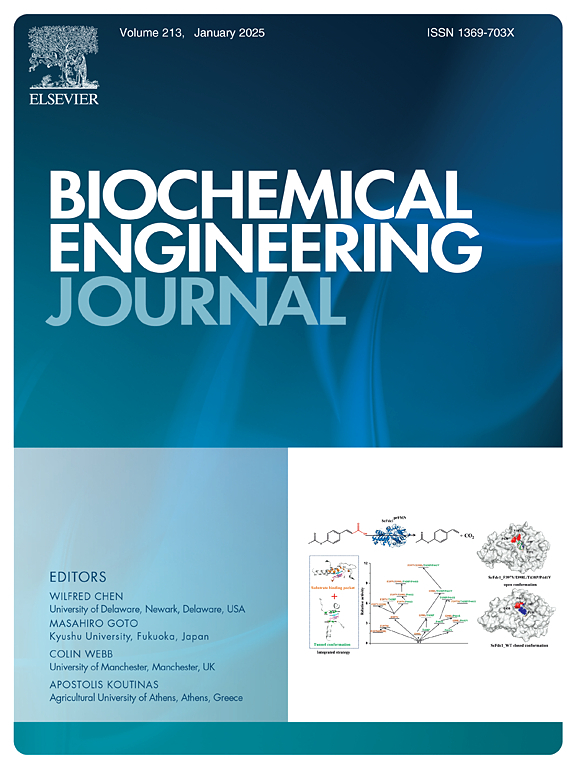Process development and environmental impact assessment of sustainable poly(3-hydroxybutyrate) separation and purification via Paraburkholderia sacchari cell lysis using crude enzymes
IF 3.7
3区 生物学
Q2 BIOTECHNOLOGY & APPLIED MICROBIOLOGY
引用次数: 0
Abstract
Downstream separation and purification of poly(3-hydroxybutyrate) has been developed via combined crude enzyme bacterial cell lysis followed by solvent extraction and circular utilisation of bacterial lysate as nutrient supplement for PHB production. Enzymatic lysis of Paraburkholderia sacchari cells was initially evaluated using crude enzymes produced via solid state fermentation of Aspergillus oryzae. The optimum protease activity (156 U per g cell dry weight) resulted in 66.9 % lysis of residual cell weight. PHB purification with 1,3-dioxolane, dimethyl carbonate, anisole, ammonium laurate and chloroform were evaluated at different processing parameters (extraction duration, temperature) using wet and dry bacterial cells as well as enzymatically lysed wet bacterial cells. The highest recovery yield (94.5 %) and purity (98.1 %) were obtained with 1,3-dioxolane at 80°C and 6 h processing time using enzymatically disrupted bacterial cells. The bacterial cell lysate was used as nutrient supplement for circular PHB production in fed-batch P. sacchari bioreactor culture leading to the production of 78.7 gPHB/L, 56.9 % (w/w) PHB content and 2.3 g/(Lꞏh) productivity. Low global warming potential (1.3 CO2-eq/kgPHB) and abiotic depletion fossil (14.4 MJ/kgPHB) were estimated for PHB purification via enzymatic cell lysis and PHB extraction with 1,3-dioxolane demonstrating the development of a sustainable and circular process for PHB production.
利用粗酶通过 Paraburkholderia sacchari 细胞裂解分离和纯化可持续聚(3-羟基丁酸)的工艺开发和环境影响评估
聚(3-羟基丁酸)的下游分离和纯化是通过粗酶细菌细胞裂解,然后进行溶剂萃取和循环利用细菌裂解物作为 PHB 生产的营养补充剂而实现的。最初使用通过黑曲霉(Aspergillus oryzae)固态发酵产生的粗酶对 Paraburkholderia sacchari 细胞的酶裂解进行了评估。最佳蛋白酶活性(每克细胞干重 156 U)可使残余细胞重量的 66.9% 降解。在不同的处理参数(萃取持续时间、温度)下,使用干湿细菌细胞以及酶裂解湿细菌细胞,评估了用 1,3-二氧戊环、碳酸二甲酯、苯甲醚、月桂酸铵和氯仿提纯 PHB 的效果。在 80°C 和 6 小时处理时间内,使用酶解细菌细胞萃取 1,3-二氧戊环的回收率(94.5%)和纯度(98.1%)最高。将细菌细胞裂解液作为营养补充物,在喂料批次 P. sacchari 生物反应器培养中进行循环 PHB 生产,可获得 78.7 gPHB/L、56.9 %(w/w)PHB 含量和 2.3 g/(Lꞏh) 生产率。通过酶解细胞和用 1,3-二氧戊环提取 PHB 来纯化 PHB,估计全球变暖潜能值(1.3 CO2-eq/kgPHB)和非生物损耗化石(14.4 MJ/kgPHB)较低,这表明开发出了一种可持续和循环的 PHB 生产工艺。
本文章由计算机程序翻译,如有差异,请以英文原文为准。
求助全文
约1分钟内获得全文
求助全文
来源期刊

Biochemical Engineering Journal
工程技术-工程:化工
CiteScore
7.10
自引率
5.10%
发文量
380
审稿时长
34 days
期刊介绍:
The Biochemical Engineering Journal aims to promote progress in the crucial chemical engineering aspects of the development of biological processes associated with everything from raw materials preparation to product recovery relevant to industries as diverse as medical/healthcare, industrial biotechnology, and environmental biotechnology.
The Journal welcomes full length original research papers, short communications, and review papers* in the following research fields:
Biocatalysis (enzyme or microbial) and biotransformations, including immobilized biocatalyst preparation and kinetics
Biosensors and Biodevices including biofabrication and novel fuel cell development
Bioseparations including scale-up and protein refolding/renaturation
Environmental Bioengineering including bioconversion, bioremediation, and microbial fuel cells
Bioreactor Systems including characterization, optimization and scale-up
Bioresources and Biorefinery Engineering including biomass conversion, biofuels, bioenergy, and optimization
Industrial Biotechnology including specialty chemicals, platform chemicals and neutraceuticals
Biomaterials and Tissue Engineering including bioartificial organs, cell encapsulation, and controlled release
Cell Culture Engineering (plant, animal or insect cells) including viral vectors, monoclonal antibodies, recombinant proteins, vaccines, and secondary metabolites
Cell Therapies and Stem Cells including pluripotent, mesenchymal and hematopoietic stem cells; immunotherapies; tissue-specific differentiation; and cryopreservation
Metabolic Engineering, Systems and Synthetic Biology including OMICS, bioinformatics, in silico biology, and metabolic flux analysis
Protein Engineering including enzyme engineering and directed evolution.
 求助内容:
求助内容: 应助结果提醒方式:
应助结果提醒方式:


